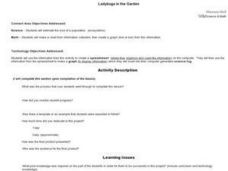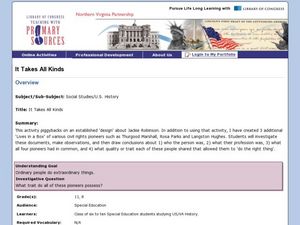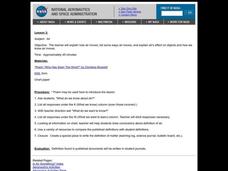Curated OER
What Do I See When I Picture Saturn?
Students create their own Saturn Discovery logs. They draw pictures of the planet and its founder. They share their drawings and writings with partners.
Curated OER
Ladybugs in the Garden
Fifth graders estimate the size a population (ecosystems) Students make a chart from information collected then create a graph (line or bar) from this information. Students do a lesson where they observed, examine, and record data...
Curated OER
Invasive Species
Students explore invasive species. In this species analysis lesson, students observe invasive species and review the impact the species have on the environment. Students work in groups to investigate the species in varying habitats....
Curated OER
Disappearing Water
Students observe the amount of water in an open container over time, and they observe the amount of water in a closed container over time. They compare and contrast the sets of observations over time.
Curated OER
Introduction to Inventions
Fourth graders construct an invention to the best of their creative ability using the teacher provided resources. They identify four scientific processes during the experiment and log them on the teacher prepared ditto.
Curated OER
Exploring With Photograms
Students observe the interaction between energy absorbed, reflected or transmitted through an object in a photochemical process with a classroom demonstration.
Curated OER
Ethical Applications of Human Genetics
Tenth graders read about, observe case study videos, and participate in live interactive broadcasts, and maintain a log book on all of the activities pertaining to the Human Genome Project.
Curated OER
In Your Own Backyard
Young scholars observe organisms in their habitat and record their observations. They then draw conclusions about the organism's habitat needs and food sources.
Curated OER
Worms in a Bottle
Students gain a better understanding of the worm and its role in the recycling of organic materials into simpler forms by constructing worm bottles and observing for 60 to 90 days.
Curated OER
It Takes All Kinds!
Students view video clips and observe similarities and differences between animals. They sort animals into groups for a zoo. They make a graph of their observations and review scientific classifications.
Curated OER
Understanding Estuaries
Students work together to develop their own estuarine ecosystem in an aquarium. They observe the aquarium daily and record them in a notebook. They discuss the different interactions they see with the class.
Curated OER
Rocket Launch
Young scholars participate in design and engineering activities pertaining to model and real rockets. They observe the launch a model rocket.
Curated OER
Simple Machines - Hardware Devices
Students examine a variety of simple hardware devices. They observe the interactions between the elements of the devices, through both hands-on and Internet exploration. They complete worksheets and design their own gadgets.
Curated OER
Photosynthesis: An enlightening experience
Students observe the effect of light on plants. They illustrate the exchange of gases between the atmosphere and the plant. Students see that plants are part of many natural cycles. They investigate how green plants use the sun's energy...
Curated OER
Air
Students complete a KWL chart on what they know about air. Reading a poem, they compare published definitions of air with the ones they created. They write the definition of air on a bullentin board. They also write their observations in...
Curated OER
Comparing Amount of Rainfall in Different Geographical Areas
Students construct rain gauges and use them to log rainfall in their school zone, local city, and region and then compare and discuss them by plotting this information.
Curated OER
The Great Backyard Bird Count
Pupils study new types of birds and explore how to keep a log of what they see.
Curated OER
HFS-What do we have growing on the school grounds?
Students observe school grounds and take pictures of plants, trees, and bushes for identification. In this plant life lesson, students identify plants with the help of guides and resources.
Curated OER
Get the Facts
Students explore spiders. In this spider lesson, students fill out KWL charts, discover facts about spiders and how to identify different spiders. Students research spiders on the Internet and do online activities.
Curated OER
Technology: Koo Koo for Clocks
Third graders design and make clocks compiling a materials list, creating adesign portfolio, and recording progress in a daily log. After making a full-size drawing of their clocks and with the assistance of high school technology...
Curated OER
Crime Scene Documentation
Students become forensic investigators. In this crime scene instructional activity, students go to the science lab which is the "scene of the crime." They collect evidence such as fingerprints, "blood" evidence, chromatography,...
Curated OER
Spider Body Parts
Young scholars identify spider body parts. In this arachnid lesson, students review the story Amazing World of Spiders and discuss the various spider body parts. Young scholars fill in the correct body parts on a copy of a blank spider...
Curated OER
What Do We Learn From the Repartiation of Alaska Native Artifacts?
Students observe and evaluate evidence of Alaska Native cultural symbols and artifacts. They research historical data from a variety of primary resources, including the Harriman expedition journals, related web sites, oral accounts,...
Curated OER
Who's Afraid of the Big, Bad Wolf?
Students compare wolves' behaviors to those of the human race. In this wolf lesson students write a story that will show that wolves are either good or evil.

























